BUICK REGAL 1994 Owners Manual
Manufacturer: BUICK, Model Year: 1994, Model line: REGAL, Model: BUICK REGAL 1994Pages: 308, PDF Size: 15.78 MB
Page 171 of 308
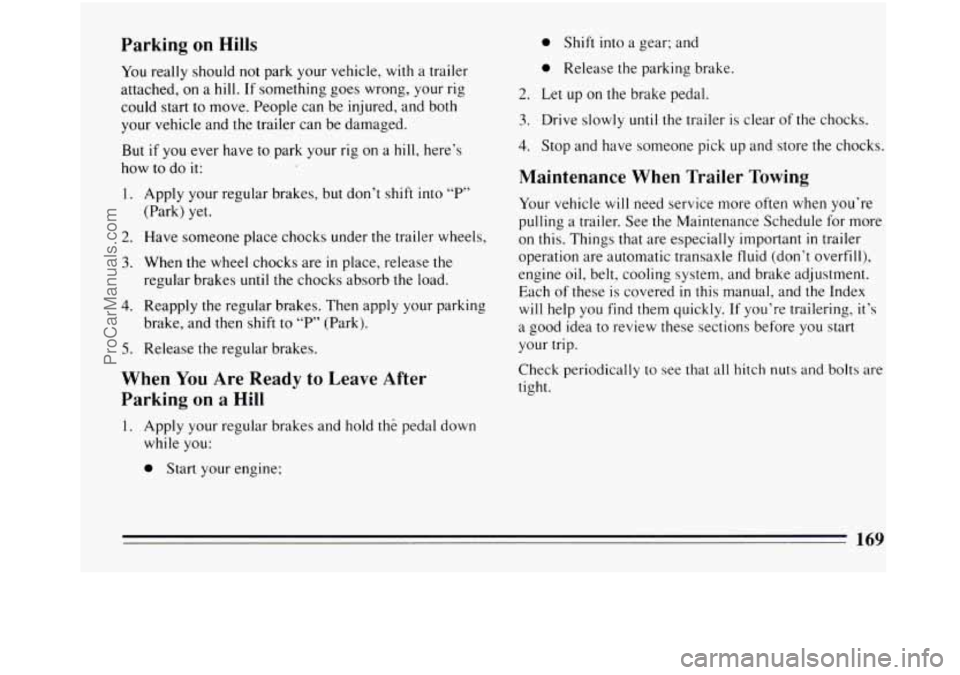
Parking on Hills
You really should not park your vehicle, with a trailer
attached,
on a hill. If something goes wrong, your rig
could start to move. People can be injured, and both
your vehicle and the trailer can be damaged.
But
if you ever have to park your rig on a hill, here’s
how
to do it:
0 Shift into a gear; and
2. Have someone place chocks under the trailer wheels,
3. When the wheel chocks are in place, release the
regular brakes until the chocks absorb the load.
4. Reapply the regular brakes. Then apply your parking
brake, and
then shift to “P” (Park).
5. Release the regular brakes.
When You Are Ready to Leave After
Parking
on a Hill
0 Release the parking brake.
2. Let up on the brake pedal.
3. Drive slowly until the trailer is clear of the chocks.
4. Stop and have someone pick up and store the chocks.
Maintenance When Trailer Towing
Your vehicle will need service more often when you’re
pulling a trailer. See the Maintenance Schedule for more
on this. Things that are especially important
in trailer
operation are automatic transaxle fluid (don’t overfill),
engine oil, belt, cooling system, and brake adjustment.
Each of these is covered
in this manual, and the Index
will help you find them quickly. If you’re trailering, it’s
a good idea to review these sections before you start
your trip.
Check periodically to see that all hitch nuts and bolts are
tight.
1. Apply your regular brakes and hold the pedal down
while you:
0 Start your engine;
169
ProCarManuals.com
Page 172 of 308
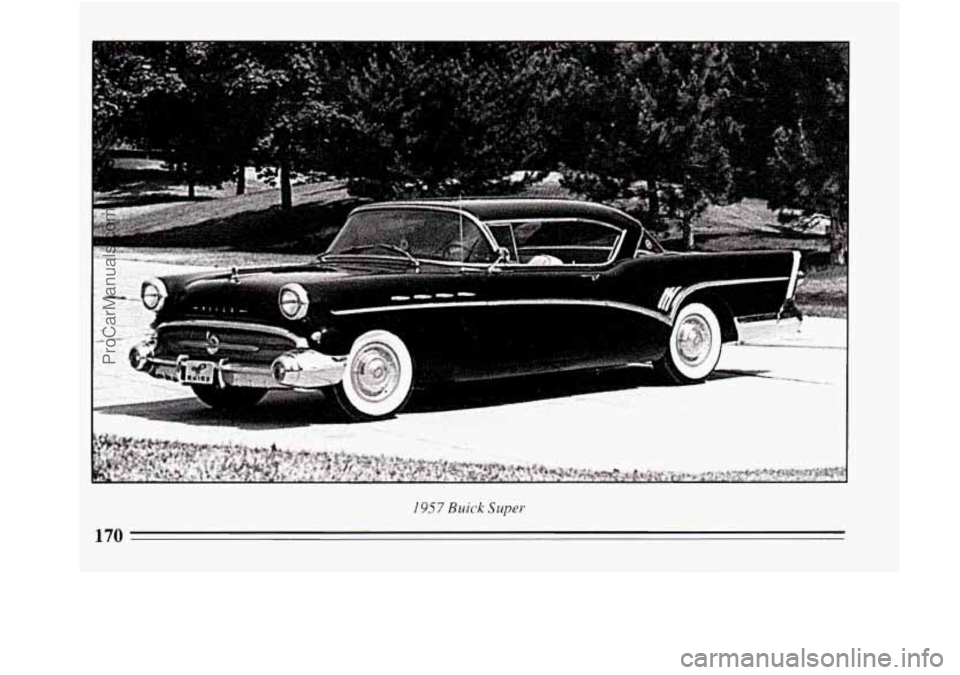
F
I957 Buick Super
170
ProCarManuals.com
Page 173 of 308
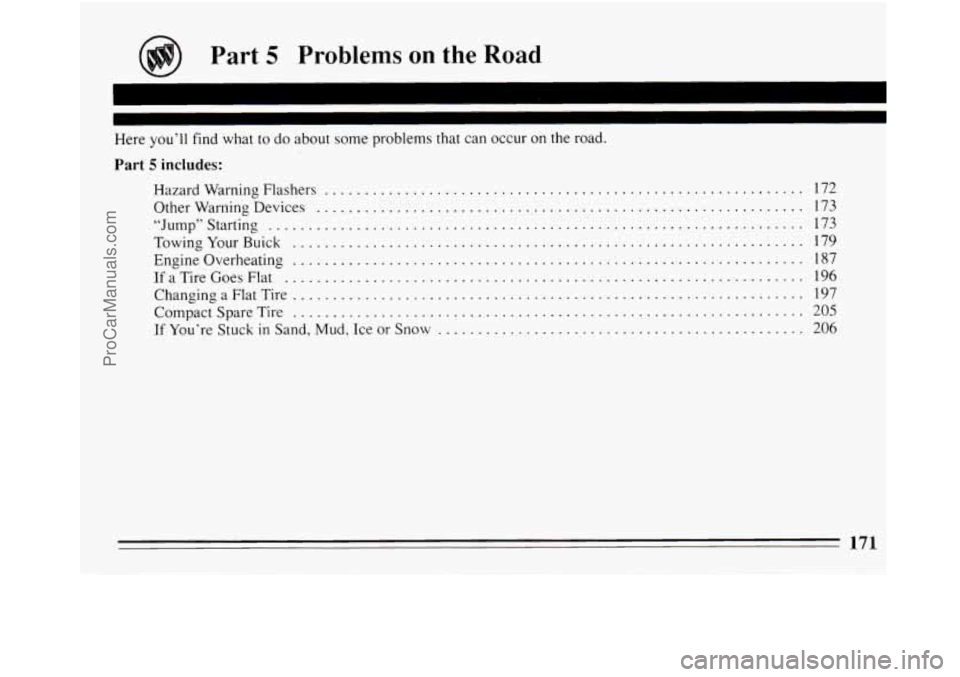
Part 5 Problems on the Road
Here you’ll find what to do about some problems that can occur on the road .
Part 5 includes:
Hazard Warning Flashers ............................................................
OtherWarningDevices .............................................................
“Jump”Starting ...................................................................
TowingYourBuick ................................................................
Engineoverheating ................................................................
IfaTireGoesFlat .................................................................
ChangingaFlatTire ................................................................
CompactSpareTire ................................................................
If You’re Stuck in Sand, Mud, Ice or Snow ..............................................
172
173
173
179
187
196 197
205
206
171
ProCarManuals.com
Page 174 of 308
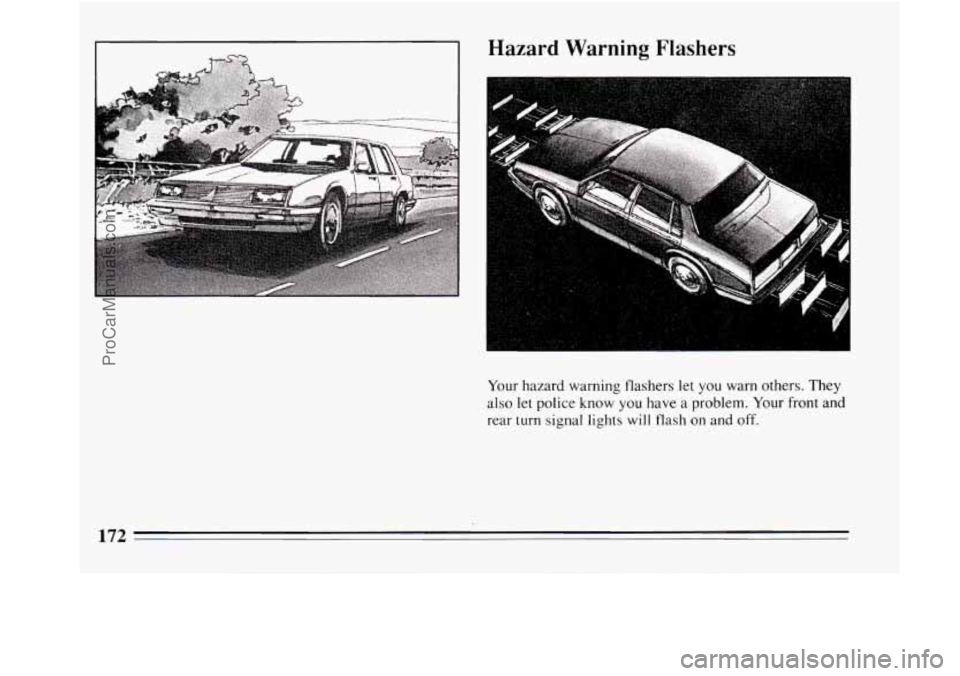
Hazard Warning Flashers
Your hazard warning flashers let you warn others. They
also
let police know you have a problem. Your front and
rear turn
signal lights will flash on and off.
172
ProCarManuals.com
Page 175 of 308
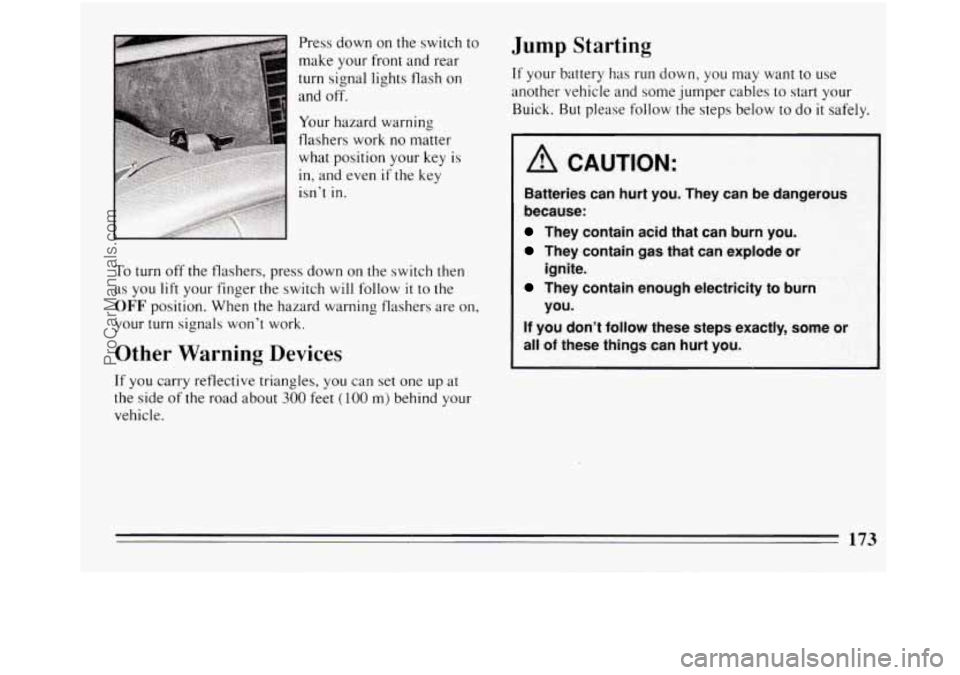
Press down on the switch to
make your front and rear
turn signal lights flash on
and off.
Your hazard warning
flashers work
no matter
what position your key is
in, and even if the key
isn’t
in.
To turn off the flashers, press down on the switch then
as you
lift your finger the switch will follow it to the
OFF position. When the hazard warning flashers are on,
your turn signals won’t work.
Other Warning Devices
If you carry reflective triangles, you can set one up at
the side of the road about
300 feet (100 m) behind your
vehicle.
Jump Starting
If your battery has run down, you may want to use
another vehicle and some jumper cables to start your
Buick. But please follow
the steps below to do it safely.
A CAUTION:
Batteries can hurt you. They can be dangerous
because:
They contain acid that can burn you.
They contain gas that can explode or
They contain enough electricity to burn
If you don’t follow these steps exactly, some or
all
of these things can hurt you.
ignite.
you.
173
ProCarManuals.com
Page 176 of 308
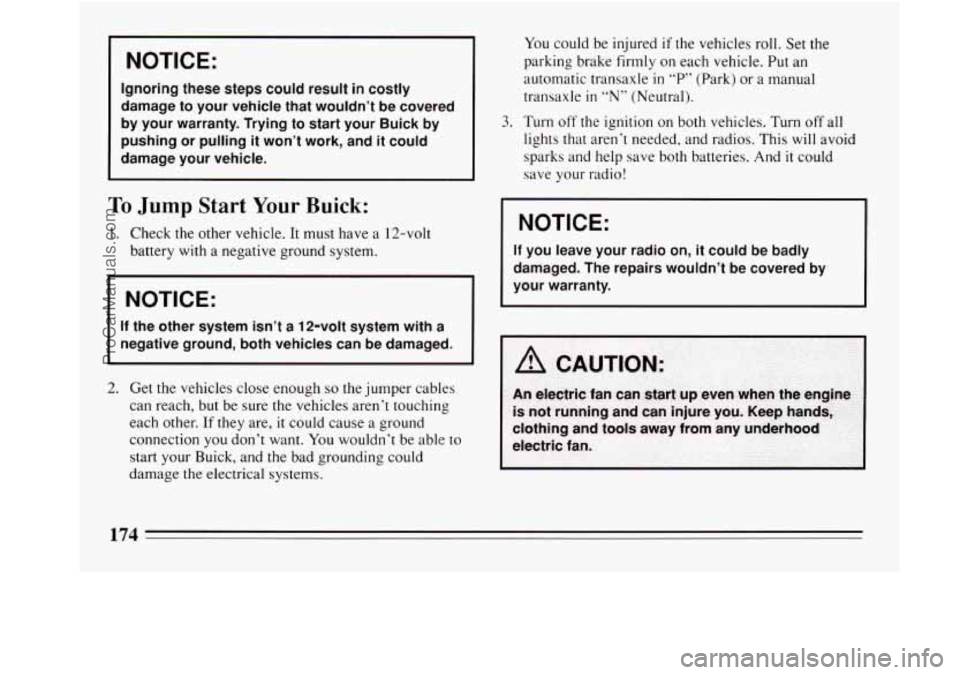
I NOTICE:
Ignoring these steps could result in costly
damage
to your vehicle that wouldn’t be covered
by your warranty. Trying to start your Buick by
pushing or pulling it won’t work, and it could
damage your vehicle.
To Jump Start Your Buick:
1. Check the other vehicle. It must have a 12-volt
battery
with a negative ground system.
NOTICE:
If the other system isn’t a 12-volt system with a
negative ground, both vehicles can be damaged.
2. Get the vehicles close enough so the jumper cables
can reach, but be sure the vehicles aren’t touching
each other.
If they are, it could cause a ground
connection you don’t want.
You wouldn’t be able to
start your Buick, and the bad grounding could
damage the electrical systems. You
could be injured
if the vehicles roll. Set the
parking brake firmly on each vehicle. Put an
automatic transaxle
in “P” (Park) or a manual
transaxle
in “N” (Neutral).
3. Turn off the ignition on both vehicles. Turn off all
lights that aren’t needed, and radios. This will avoid
sparks and help save both batteries. And
it could
save your radio!
1 NOTICE:
If you leave your radio on, it could be badly
damaged. The repairs wouldn’t be covered by
your warranty.
ProCarManuals.com
Page 177 of 308
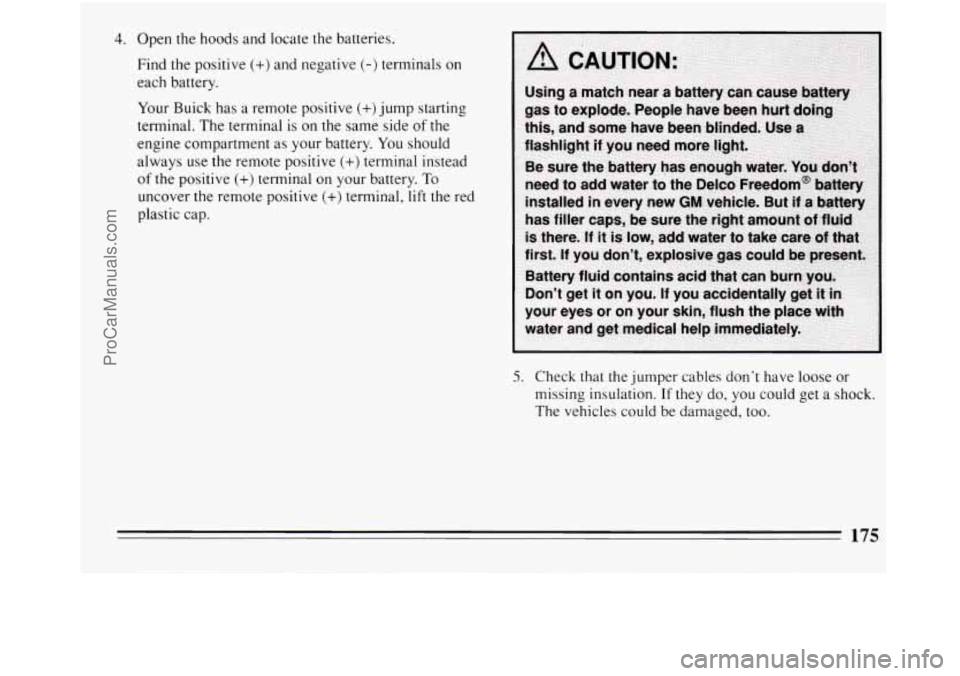
4. Open the hoods and locate the batteries.
Find the positive
(+) and negative (-) terminals on
each battery.
Your Buick has
a remote positive (+)jump starting
terminal. The terminal is on the same side
of the
engine compartment as your battery. You should
always use the remote positive
(+) terminal instead
of the positive (+) terminal on your battery. To
uncover the remote positive (+) terminal, lift the red
plastic cap.
5. Check that the jumper cables don’t have loose or
missing insulation. If they do, you could get a shock.
The vehicles could be damaged, too.
175
ProCarManuals.com
Page 178 of 308
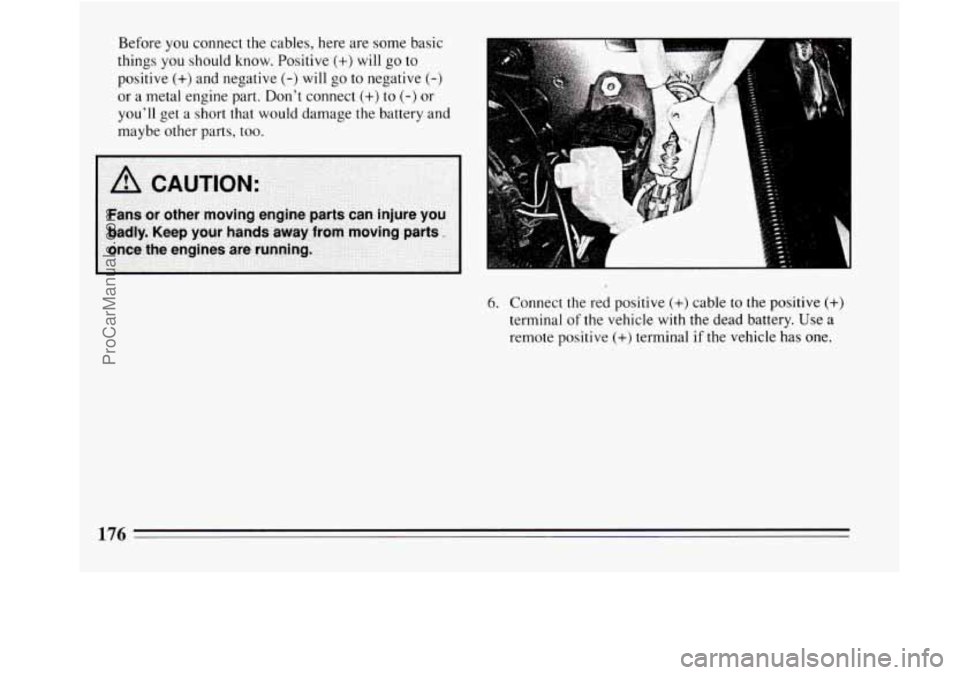
Before you connect the cables, here are some basic
things
you should know. Positive (+) will go to
positive
(+) and negative (-) will go to negative (-)
or a metal engine part. Don't connect (+) to (-) or
you'll get a short that would damage the battery and
maybe other parts, too.
6. Connect the red positive (+) cable to the positive (+)
terminal of the vehicle with the dead battery. Use a
remote positive (+) terminal if the vehicle has one.
176
ProCarManuals.com
Page 179 of 308
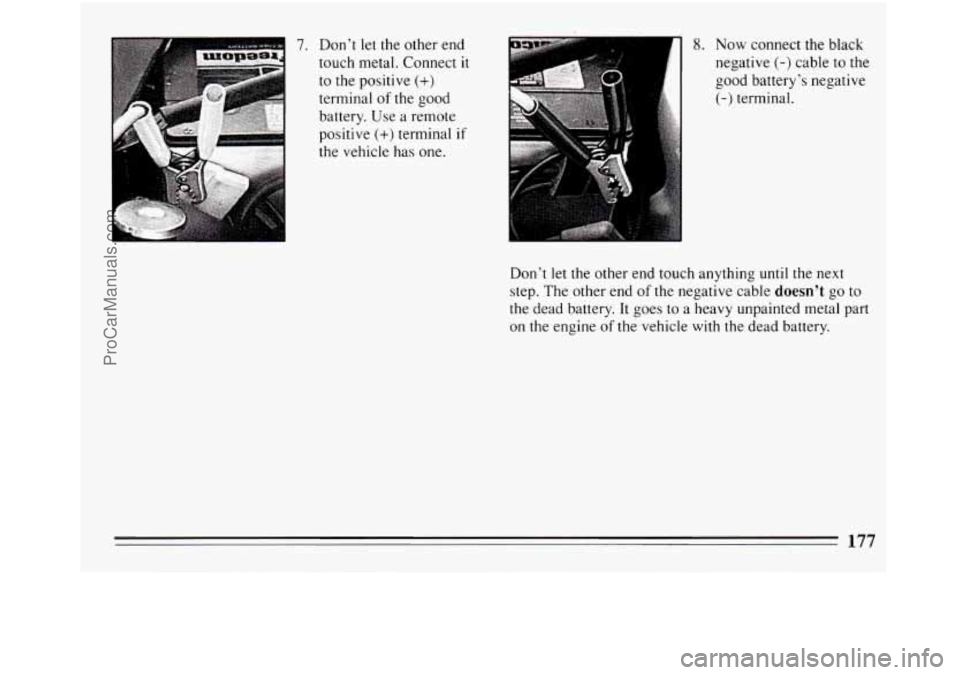
7. Don’t let the other end
touch metal. Connect
it
to the positive (+)
terminal of the good
battery. Use a remote
positive
(+) terminal if
the vehicle has one.
1
8. Now connect the black
negative
(-) cable to the
good battery’s negative
(-) terminal.
Don’t let the other end
touch anything until the next
step. The other end
of the negative cable doesn’t go to
the dead battery. It goes to a heavy unpainted metal part
on the engine
of the vehicle with the dead battery.
177
ProCarManuals.com
Page 180 of 308
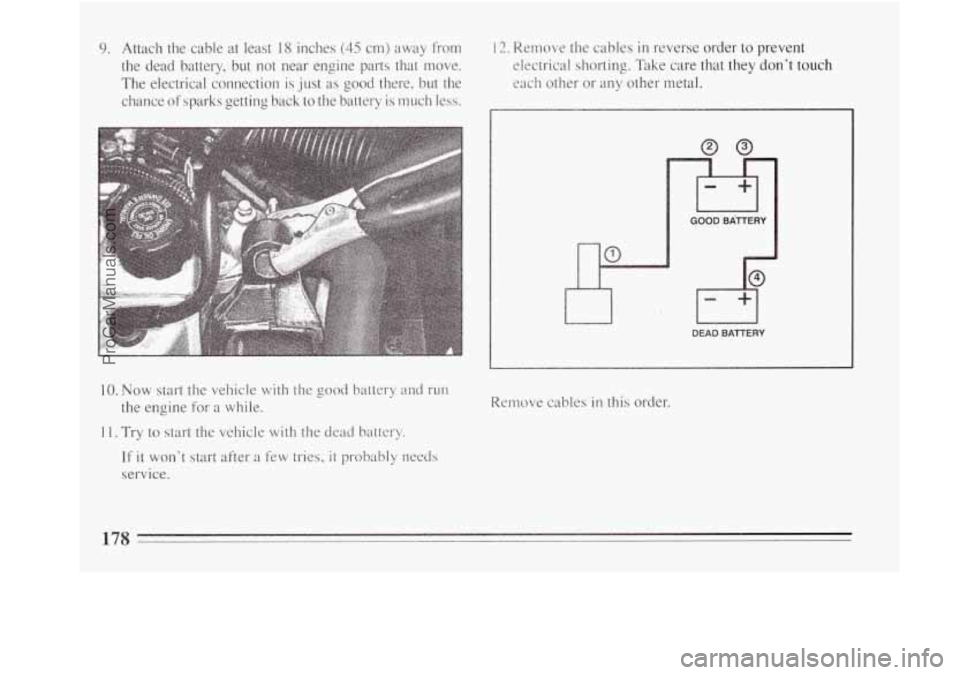
9. Attach the cable at least 18 inches (45 cm) away from
the dead battery, but not near engine parts that move.
The electrical connection is just
as good there? but the
chance
of sparks getting back to the battery is much less.
12. Remove the cables in reverse order to prevent
electrical shorting. Take care that they don’t touch
each other or any other metal.
10. Now start the vehicle with the good battery and run
the engine for a while.
11. Try to start the vehicle with the dead battery.
If it won’t start after a few tries, it probably needs
service.
GOOD BATTERY
DEAD BATTERY
Remove cables in this order.
178
ProCarManuals.com